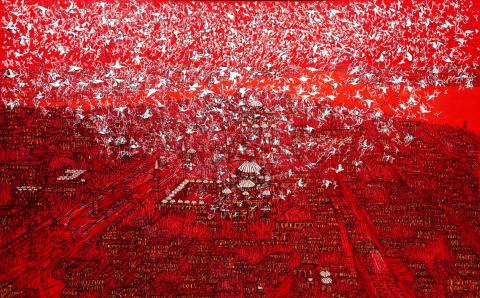Rhythm, lines and Turkish tradition are among the words used to describe the art of Devrim Erbil, a key figure in the development of modern Turkish painting whose artistic career has spanned more than half a century. The National Museum of History (國立歷史博物館) is currently holding an exhibition, Poetical Abstraction From Istanbul (詩意的抽象—來自伊斯坦堡), of work by the internationally-renowned artist, including recent abstract paintings and textile-art, that eloquently illustrate his preoccupations with motifs such as birds, trees, rhythmic composition and the cityscapes of Istanbul.
Born in 1937 in the carpet-weaving province of Usak, Central Anatolia, Erbil studied painting at the respected State Academy of Fine Arts in Istanbul during the 1950s, and soon garnered recognition as an abstract painter at home and abroad. A prolific artist who, at the age of 76, still reportedly works seven to 12 hours a day, Erbil has also served as an academic at several art institutions in Turkey and helped to influence a younger generation of Turkish artists.
Although trained in the abstract tradition of European masters such as Paul Klee and Piet Mondrian, Erbil nevertheless seeks inspiration in the culture, tradition and landscapes of Turkey, particularly Anatolia, the Asian part of the nation. He renders Istanbul in intricate lines and shapes and always from an aerial perspective. From a distance, the city’s maze of streets, mosques and the Bosphorus, a strait that is part of the border separating Europe and Asia, appear sketched or engraved on the canvas and often painted in vibrant colors of red, green and Turkish blue. A closer look, however, reveals an immense complexity composed of straight and broken lines, curves and their variations in various hues.

Photo courtesy of the Turkish Trade Office in Taipei
Erbil’s abstract paintings are also suffused with images of nature. Subjects like the flapping of a bird’s wings or the branches and leaves of a tree, which seem to expand and grow to infinity, are often unrecognizable, while a sense of rhythmic motion and dynamism is deeply felt in the artist’s intricately detailed rendering.
Believing that art is made for sharing, Erbil has worked with a variety of media that ranges from mosaics, ceramics and stained glass to tapestry. Among them, Anatolian carpet occupies a special position in the creative world of Erbil, who once said that carpets are the Turks gift to humanity. Several of Erbil’s textile-art works that adopt ancient weaving techniques are on display at the museum, aiming to change the viewer’s ideas of carpets not only as a piece of decoration on the floor but as an artwork that can be hung on the wall.
■ National Museum of History (國立歷史博物館), 49 Nanhai Rd, Taipei City (台北市南海路49號), tel: (02) 2361-0270. Open Tuesdays to Sundays from 10am to 6pm. General admission: NT$30. On the Net: www.nmh.gov.tw

Photo courtesy of the Turkish Trade Office in Taipei
■ Until Oct. 2

Photo courtesy of the Turkish Trade Office in Taipei

Photo courtesy of the Turkish Trade Office in Taipei

In the March 9 edition of the Taipei Times a piece by Ninon Godefroy ran with the headine “The quiet, gentle rhythm of Taiwan.” It started with the line “Taiwan is a small, humble place. There is no Eiffel Tower, no pyramids — no singular attraction that draws the world’s attention.” I laughed out loud at that. This was out of no disrespect for the author or the piece, which made some interesting analogies and good points about how both Din Tai Fung’s and Taiwan Semiconductor Manufacturing Co’s (TSMC, 台積電) meticulous attention to detail and quality are not quite up to

April 21 to April 27 Hsieh Er’s (謝娥) political fortunes were rising fast after she got out of jail and joined the Chinese Nationalist Party (KMT) in December 1945. Not only did she hold key positions in various committees, she was elected the only woman on the Taipei City Council and headed to Nanjing in 1946 as the sole Taiwanese female representative to the National Constituent Assembly. With the support of first lady Soong May-ling (宋美齡), she started the Taipei Women’s Association and Taiwan Provincial Women’s Association, where she

Chinese Nationalist Party (KMT) Chairman Eric Chu (朱立倫) hatched a bold plan to charge forward and seize the initiative when he held a protest in front of the Taipei City Prosecutors’ Office. Though risky, because illegal, its success would help tackle at least six problems facing both himself and the KMT. What he did not see coming was Taipei Mayor Chiang Wan-an (將萬安) tripping him up out of the gate. In spite of Chu being the most consequential and successful KMT chairman since the early 2010s — arguably saving the party from financial ruin and restoring its electoral viability —

It is one of the more remarkable facts of Taiwan history that it was never occupied or claimed by any of the numerous kingdoms of southern China — Han or otherwise — that lay just across the water from it. None of their brilliant ministers ever discovered that Taiwan was a “core interest” of the state whose annexation was “inevitable.” As Paul Kua notes in an excellent monograph laying out how the Portuguese gave Taiwan the name “Formosa,” the first Europeans to express an interest in occupying Taiwan were the Spanish. Tonio Andrade in his seminal work, How Taiwan Became Chinese,